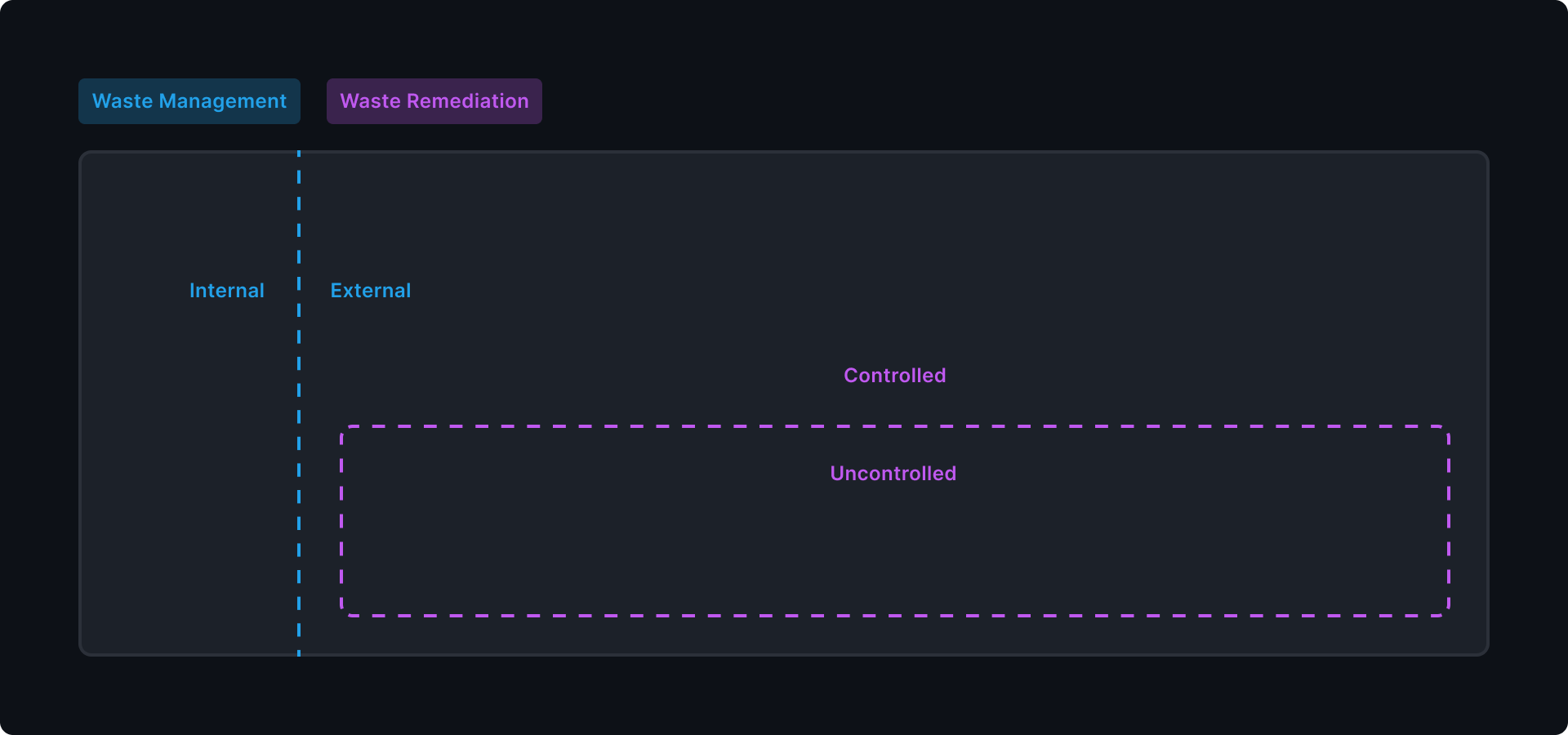Systemic Analysis
Adopting a systemic analysis to assess the waste lifecycle is essential to prevent ambiguity and favor precise definitions regarding its relation with responsibilities. Before diving deep into the specifics, it's important to clarify the key terms:
- Domains. Fields from where reality is observed, defined by a criterion.
- Systems. The distinctive zones of influence within a domain.
- Boundaries. The limits that define what is included and excluded by a system.
- Events. The actions that happen within a system and through its boundaries.
Waste Domains
Domains define fields of knowledge and are crucial in determining waste accountability. In the waste lifecycle, two distinct domains can be identified to separate risk assessment from harm assessment:
| Domain | Waste Management | Waste Remediation |
|---|---|---|
| Object | Risks | Harm |
| Criterion | Individual Control | Collective Control |
| Subjects | Entities that create risks or that provide definitive solutions | Entities that cause harm or that remediate it |
| Description | The focus is on the emergence of risks and its effective management to prevent harm. The objective is to identify where responsibility starts and ends for a particular risk. | The focus is on harm materialization and its appropriate remediation to prevent further losses. The objective is to identify where harm occurs and where it ends. |
The Concept of Control
Control is the ability of an entity to manage waste and its associated processes to a degree that it does not create externalities in the form of indirect costs, such as social or environmental harm, beyond an accepted level. This usually translates to the direct handling and processing of waste materials.
- The waste management domain focuses on who creates waste, which carries a need for control, and who provides a definitive solution to eliminate the need for control. The individual perspective examines transactions of control on a one-to-one basis, such as when an entity transfers waste to another.
- The waste remediation domain focuses on who loses or gains control of waste. Logically, this happens only once waste has been created. The collective perspective assesses control in a broader sense, questioning whether any entity retains control over waste.
Boundaries & Systems
Defining systems and their boundaries within each domain is fundamental to identify instances where responsibilities emerge or are extinguished, in both domains. These systems delineate the zones of influence over waste, a fundamental concept to assess the roles and responsibilities associated with waste. Boundaries serve as demarcations that define the extent of control and responsibility within each domain. Within these boundaries, distinct systems operate based on the degree of control and responsibility exerted over waste.
-
Waste management boundaries are drawn around the areas of individual or singular entity control, delimiting the zone of influence where an entity exercises direct oversight over waste from areas beyond direct control, like third parties or zones under no direct control.
System Definition Example Internal The realm within which an entity has direct control over its activities and property. A company generating scrap waste that is still within its premises. External The realm beyond an entity's direct control, involving broader interactions. A company selling a product, transferring the ownership of the product and its packaging. -
Waste remediation boundaries distinguish between controlled environments and the broader natural world. Controlled boundaries encompass areas where waste is managed under direct human oversight. Uncontrolled boundaries encapsulate the natural world, where waste escapes human control and interacts with ecosystems.
System Definition Example Controlled The realm where waste is under direct human control. Waste contained in a public dumpster in a city. Uncontrolled The natural world, beyond human control, including air, water, land, and living organisms. Plastic debris in the ocean or a natural water body.

Open Systems & Their Environment
All systems are defined by their interaction with the environment, exchanging materials, energy, or information. In the context of waste management and remediation, open systems emphasize the dynamic nature of waste as it moves across boundaries. However, as domains intersect, systems within a domain can not, showcasing that while different fields of knowledge can overlap, the boundaries within each domain are not diffuse.
Material Flows
Understanding material flows within and across system boundaries is crucial for an effective assessment of waste responsibility. Material flows are categorized based on their direction and impact from an organizational perspective:
| Flow Type | Direction | Examples |
|---|---|---|
| Inputs | Materials entering an internal system. | These can include, among others, materials for production, waste for processing or recovery. |
| Outputs | Materials exiting an internal system. | These flows often represent the output of production activities and the residual waste requiring further management. |
| Internal | Materials being moved or transformed within an internal system. | These flows can involve the processing of materials into finished goods, the internal recycling or reuse of waste, and the management practices that reduce the volume or toxicity of waste before it exits the system. |
The analysis of material flows involves identifying, quantifying and characterizing these movements. It encompasses two key steps:
- Material Flows Mapping. Creating a comprehensive overview of where materials come from, how they move through the system, and where they end up.
- Responsibility Evaluation. Assessing the impacts of material flows to understand the implications on third parties and to identify the emergence of responsibilities of different actors within value chains or the provision of services to fulfill them.